 |
Specifications:
| Product Name | ToughTech mini-Q (with WriteLock) ToughTech Secure mini-Q [with WriteLock] |
| Interface Types & Speeds | eSATA: up to 3000 Mbps Dual FireWire 800 (400 compatible): up to 800Mbps |
| Chipset | Oxford 934 |
| Drive Compatibility | 2.5″ SATA (Serial-ATA) hard drives, 9.5mm height |
| Encryption | Hardware-based AES 128-bit or 256-bit encryption engine (“Secure” models only) |
| Operating System Requirements | Windows 7, Vista, or XP MAC OS X Linux distributions that support the connection type used |
| External Power Supply | 100-240VAC, 5V/1A (included) |
| Compliance | FCC, CE, RoHS |
| Shipping Weight | 3 pounds without drive; 5 pounds with drive |
| Product Dimensions | 5.2″ x 3.15″ x 0.79″ inches (13.2 x 8 x 2 cm) |
| Support | We don’t want anything to go wrong with your product. But if it does, Tech Support is standing by and ready to help. Contact us at cru-dataport.com/support.com/support or weibetech.com/techsupport. Phone support also available at (800) 260-9800WiebeTech is a brand of CRU |
Closer Look:
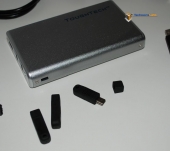 |
 |
| The mini-Q comes with three access dongles | The drive will power-up, but without a dongle connected to the drive it will not appear as a storage device. |
The mini-Q uses an encryption dongle to activate the drive for access. The kit comes with three dongles which allows you to use this drive in several scenarios such as one drive with only three people who have access to the data at one location or ship the drive to each user and only the users with the security dongles can access the data.
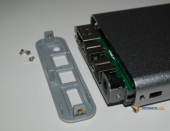 |
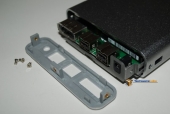 |
| Three small screws were removed to access the internals of the mini-Q | The mini-Q has the options of USB 2.0 or eSATA or dual FireWire. |
We opened the mini-Q to show you what the inside is made up of. The mini-Q has three small screws holding the I/O panel and the drive inside which seemed a little weak, but rest assured without the mini-Q’s circuit board and dongles it is impossible to access the data on the drive. Of course that is the thief has access to a system that can decipher AES 128bit or 256bit encryption which is not likely. Once the three mini screws were removed the drive and circuit board slide out.
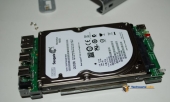 |
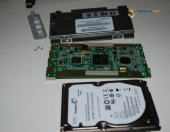 |
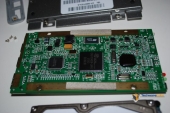 |
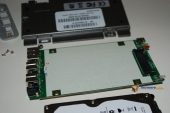 |
Once the internal circuit board with hard drive is removed, we had to remove four screws which secured the hard drive to the circuit board and bottom plate. Once the drive was removed we are able to get a closer look at what makes up the mini-Q’s encryption components. We have seen many portable drives in the past, but none of them have had this much circuitry included.
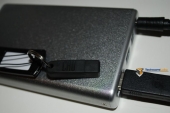 |
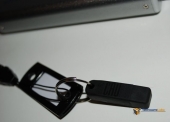 |
 |
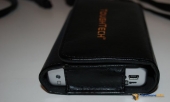 |
The mini-Q does come with a carrying case which helps protect the case while in transit. There is no room for anything else such as the I/O cables though, so it is likely you will need to have a set of cables at each location you plan on using the drive at. Of course you wouldn’t keep the dongle with the drive, so as stated earlier the dongles come with lanyards and tagged key ring.

Lots of places won’t allow portable drives of any sort (including cell phones) on the premises, especially encrypted ones, and the dongle will freak out the security people who will believe it is another portable device. Of course, people who work at these institutions (such as military facilities and government contractors) already know these devices can get them fired and their security clearance revoked.
Doug,
Good point, so it would be in the consumer’s best interest to check with their employer if such a device is allowed. This is not an answer to every company’s problems, but it can be used in some places. Likely this type of device would be approved by the owner of a company to manage their off-site backups. Another idea would be the data security group at company may use the mini-Q to transport their data. Since it would be the “freaked out” security group who owns the device, there shouldn’t be security issues there.